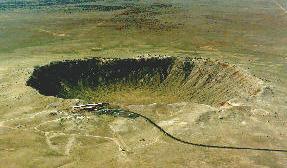 Composition of the comet nucleus
Composition of the comet nucleusThey are believed to be made of material, originating in the outer part of the solar system. This unchanged "primitive" material makes them interesting to learn about conditions during the early solar system. Comets are frequently called `dirty snowballs', because they contain very small dust grains and pieces, "glued" together by the frozen gases. Young comets contain many frozen gases, the most common being ordinary water. In the low pressure conditions of space, water sublimes, that is, it goes directly from solid to gas -- just like dry ice does on Earth. Water makes up 75-80% of the volatile material in most comets. Other common ices are CO, CO2, methane (CH4), and ammonia (NH3). Volatiles and solids are well mixed throughout the nucleus of a new comet approaching the Sun for the first time. As a comet ages from many trips close to the Sun, it loses most of its ices. Comets can not live for long because they `melt' with each approach to the Sun. After several hundred orbits, the comet nucleus is all but destroyed.
The origin of Comets
A spherical shell of more than 100 billion comets surrounds
the solar system at a distance of 75,000-150,000 A.U., called the
Oort Cloud. While the comets
move very slowly in this huge cloud, a passing star may change their
orbits enough to force some of them into the inner part of the solar
system. In 1951, G. P. Kuiper, noting that Oort's cloud of comets
did not adequately account for the population of short-period comets (those
with periods less than 200 years), proposed the existence of a second,
disk-shaped cloud outside the orbit of Neptune (now called the
Kuiper belt) as a source for these comets. This theory was
validated in 1992 with the discovery of the first of the more
than 70,000 so-called trans-Neptunian objects, bodies
> 100 km in diameter in an orbit 30-50 A.U. from the Sun.
Pluto, Charon and Triton look to be Kuiper belt objects.
 The threat of Comet and Asteroid impacts to Earth
The threat of Comet and Asteroid impacts to Earth
50,000 years ago, a huge iron-nickel meteorite, hurtling at about 40,000
miles per hour, struck the rocky plain of Northern Arizona with an explosive
force greater than 20 million tons of TNT. The meteorite estimated to have
been about 150 feet across and weighing several hundred thousand tons, in less
than a few seconds, left a crater 700 feet deep and over 4000 feet across.
The object causing the impact looks to have been an asteroid.
As impressive as it looks, the formation of Meteor Crater did not have a truly significant impact on life on Earth. However, approximately every 100,000 years, a global catastrophic event is expected. Click Here for a graph. The size of such objects, loosely referred to as `Dinosaur Killers', are about 1 km. Evidence of such collisions are seen in at least two past major mass extinction (when more than 95% of species go extinct) appear to be linked to such impacts. The first dates back 250 m.y.o (Late Permian Period). The second occurred 65 m.y.a (Late Cretaceous Period), when dinosaurs went extinct. Scientists even believe they have found the impact site, on the Yucatan peninsula.
In a single life time, a typical event would be the collision of a 50m object with Earth. Such an object would wipe out a region the size of Rhode Island.